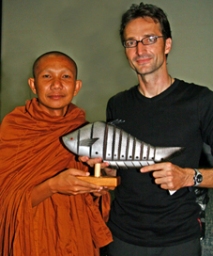Buddhist film is audience's choice at Cambodian festival
July 6 2007:
 |
 |
 |
ABE's Ven.Hiek Sopheap receives film award from CI's Wayne McCallum |
ARC’s sister group the Association of Buddhists for the Environment (ABE) has won the Audience Choice prize in the Cambodia Environment Film Festival, hosted by Conservation International (CI).
The short film titled Community Forestry, Buddhism and Cambodia Heritage features ABE's work among Buddhist communities in Cambodia including a new tradition of ordaining trees in order to protect them. It was commissioned and directed by Venerable Hiek Sopheap of ABE.
ARC took the opportunity to ask Wayne McCallum of CI-Cambodia about this first Environmental Film festival, and about how CI sees the role of Buddhism and Buddhist traditions in Cambodia’s environmental future.
ARC: Are there many films in Cambodia about the environment?
WM: A surprising number. Many NGO programs produce them as part of their activities, either as extension tools for environment education with the communities they work with or as a means of communicating the substance of their programmes to a wider audience.
There were so many that I could easily have shown a further night of Cambodia environment films had I wanted to. Most of the films are short – around 20 or 30 minutes, and are usually in Khmer with English sub-titles.
ARC: What changes have you noticed in environmental consciousness in Cambodia over the past few years?
WM: This is a challenging question. Like in China, there is a strong “growth ethos” running through the country - which means that in the past it has been mostly international NGO's that have been promoting environmental messages in Cambodia.
 |
| "Personally, I am very excited about the possibilities of working with the local Sangha in the Cardamoms through the guidance and work of ABE. I guess I see the relationship as being as much about how we help ABE to grow so that it is effective (in terms of its mission statement) as about the delivery of biophysical goals and project outputs." Wayne McCallum, CI-Cambodia
|
|
 |
 |
However, I have noticed that as part of this work a wide array of civil society groups have begun to emerge. These groups are often linked to particular issues like land conflict, but they have environment issues at their core.
Environmental activity has also manifested itself through other initiatives such as community-led video, community forestry programmes and local NGOs – including ABE – which have formed to promote environmental education. There is also an emerging group of young Khmers with an environment education background. So there are, if you like, the 'green shoots' of an emergent environmental consciousness in Cambodia.
ARC: How seriously is CI taking the Buddhist involvement in the environment? How about your own interest in the Buddhist work?
WM: Conservation International in Cambodia is particularly interested in the possibilities that working with ABE offers as a means for promoting environmental conservation in the Central Cardamoms. We are aware that ABE is an infant organization and needs to be nurtured carefully in its efforts to integrate its goals with those of the Conservation International / Forestry Administration programme.
Personally, I am very excited about the possibilities of working with the local Sangha in the Cardamoms through the guidance and work of ABE. I guess I see the relationship as being as much about how we help ABE to grow so that it is effective (in terms of its mission statement) as about the delivery of biophysical goals and project outputs.
ARC: Are there any other particularly notable projects? Is this the first occasion of a film award from CI? What are your hopes for the future development of this idea?
WM: Together with the festival, CI ran a participatory photography course in the Central Cardamoms district of Thma Bang (see the attached PDF). This has proved a very effective tool for giving a 'voice' to a community demographic that often goes unheard in village discussion, as well as building human capital within this group.
This was the first ever Environment Film Festival in Cambodia. I hope it will continue in the future, but it is up to others to pick up the torch and run with it as I depart Cambodia at the end of the year. It would be great to see local Khmers lead and facilitate future environment film festivals!!
Personally, I would like to develop a community film making project for the Central Cardamoms, giving local people the power of film to tell their stories.
ARC: I liked the award of a wooden fish. Is it made in Cambodia? Is there a story about how it was chosen?
A: The fish was a (slightly physically incorrect) depiction of a dragon fish - Asian Arowana – which is extremely rare, and targeted for the aquarium trade. The award was purchased from a local market. It was selected for the Audience Choice Award because the Central Cardamoms has the last reminding wild populations of a particular dragon fish species in the world. CI, together with the FA and local communities, has worked diligently to protect these remnant populations from people trying to put them in aquariums. A prize centred on this species therefore seemed a good way of linking the award to something relevant to the work of CI in the Central Cardamoms.
Links:To contact the Association of Buddhists for the Environment, link here.
To download the Cambodia Environment Film Festival 2007 brochure in English and Khmer link here.
To download a CI-Cambodia brochure on their participatory photography project in the Cardamoms link here.
|

